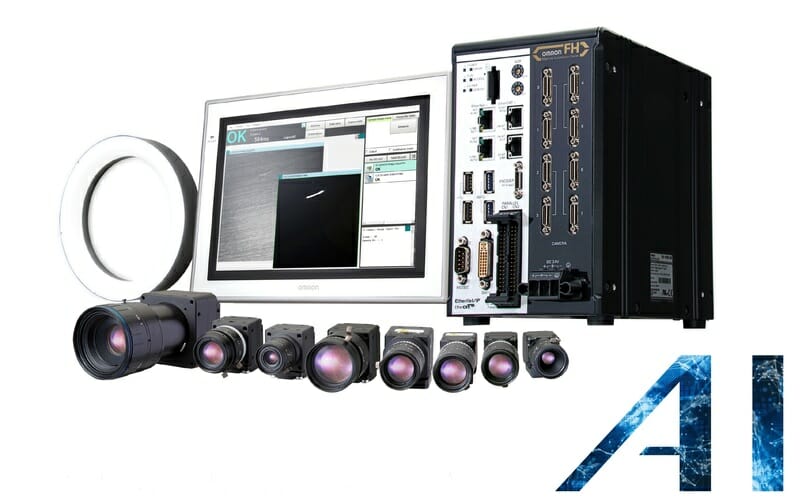The image processing system identifies subtle defects with human-like sensitivity to achieve higher defect detection rates.
OMRON has announced the global release of its new FH Series Vision system with the industry’s first defect detection AI technology that identifies defects without learning samples. This artificial intelligence technology, which reproduces human sensibility and the techniques of skilled inspectors, reliably detects defects that were once difficult to capture, automating human vision-based visual inspection.
Manufacturers are facing intense pressure to automate processes that rely on the senses of experienced human workers. Particularly when it comes to visual inspection, it’s important to reliably identify subtle defects even on flexible lines producing a wide range of items. Traditionally, the sensitivity and knowledge of technicians with long-term experience have been key. However, nowadays people may need to avoid working in the same space on the manufacturing sites in order to protect them from COVID-19, which leads to growing demand for labor-saving automated visual inspection.
Artificial intelligence is now reaching the stage where it can recognize object features as well as humans and automatically learn criteria. While a lot of AI solutions face challenges with large amounts of image data, specialized hardware and engineering expertise, OMRON has made great progress in enabling its widespread use.
To solve these challenges, OMRON developed the industry’s first defect detection AI that reproduces the techniques of skilled inspectors. This AI is now part of the FH Series Vision System. Over 30 years of OMRON’s knowledge of image processing and visual inspection have been built into this new product to maximize the inspection capability using AI without learning huge amounts of data. AI has traditionally required a special environment, but OMRON’s lightweight solution has been integrated into a system component. No dedicated AI engineer is required for setup and adjustment at manufacturing sites.
OMRON is committed to bringing innovation to manufacturing sites by materializing its unique concept called “innovative-automation” to solve manufacturing site issues. “As OMRON strives to get close to, and even beyond, the performance of the human eye, we continue to further accumulate data and conduct research for the development of the latest AI technology. By expanding the scope of what can be automated in visual quality inspection, we free people from simple and monotonous work, while improving the process quality and stability,” stated Jan Nieswandt, Product Marketing Manager for Vision and RFID at Omron Europe.
Key Features
- AI captures defects with human-like sensitivity
- A new AI-based image filter reproduces the technique that skilled inspectors use to identify a defect on any product background.
- Scratches and blemishes that were once difficult to capture can now be identified even without the use of samples or adjustment.
- AI identifies good products like experienced inspectors
- The FH Series can determine acceptable variation tolerances.
- An AI Fine Matching tool learns from the image data of non-defective products to quickly acquire the “expertise” that inspectors develop over the course of many years. This reduces costs and boosts productivity through automation.
- AI reduces overdetection.
- No special environment is required
- AI has traditionally required a high-end environment, but OMRON’s lightweight solution comes in the form of user-friendly processing items that have been integrated into its popular FH Series hardware.
- No special hardware for AI or AI engineer is required.
(*)Industry’s first AI that captures defects with human-like sensitivity without learning, in vision components or vision libraries integrated into machines. Based on OMRON investigation in June 2020.
About “innovative-Automation”
As a leader in industrial automation, OMRON has extensive lines of control components and equipment, ranging from image-processing sensors and other input devices to various controllers and output devices such as servo motors, as well as a range of safety devices and industrial robots. By combining these devices via software, OMRON has developed a variety of unique and highly effective automation solutions for manufacturers worldwide. Based on its reservoir of advanced technologies and comprehensive range of devices, OMRON set forth a strategic concept called “innovative-Automation” consisting of three innovations or “i’s”–“integrated” (control evolution), “intelligent” (development of intelligence by ICT), and “interactive” (new harmonization between people and machines). OMRON is now committed to bringing innovation to manufacturing sites by materializing this concept.
About OMRON Corporation
OMRON Corporation is a global leader in the field of automation based on its core technology of “Sensing & Control + Think.” OMRON’s business fields cover a broad spectrum, ranging from industrial automation and electronic components to social infrastructure systems, healthcare, and environmental solutions. Established in 1933, OMRON has about 30,000 employees worldwide, working to provide products and services in around 120 countries and regions. For more information, visit OMRON’s website https://www.omron.com/.








